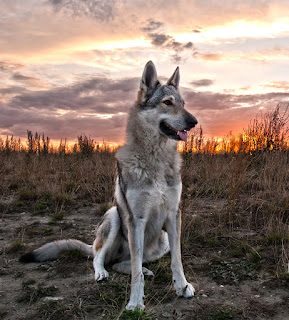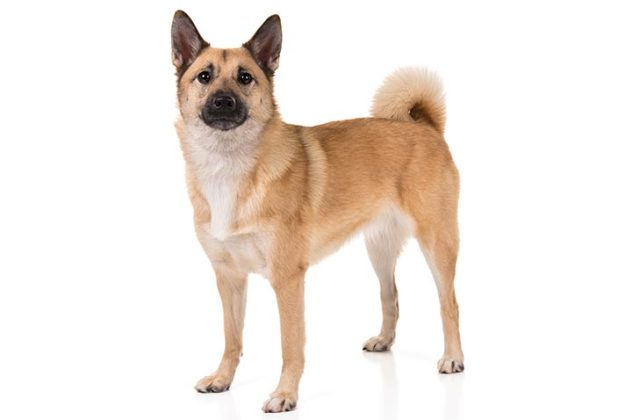Everything about your Czechoslovakian Wolfdog
Named for its wolf-like appearance, the Czechoslovakian Wolfdog is a new breed of dogs developed in Czechoslovakia and is considered to be rare. These herding dogs have a rectangular build with large barrel-shaped chest, broad neck, muscular belly and a bushy tail. They stand upon two pairs of straight forelimbs, and strong, long-calved hind limbs. Its muzzle is black, ears are erect and eyes are amber-colored and positioned obliquely. They are best suited for rural setting where they have lots of space to roam, and a family property to guard. They are used to living in cold climates.
Overview
The Czechoslovakian Vlcak or Czech Wolf Dog is a relatively new breed of dog first bred as a military attack dog. This breed is the result of an experiment in 1955 that involved crossing 48 working line German Shepherds with Carpathian wolves. The idea behind creating the Czech Wolf Dog was to create a powerful breed with the trainability, temperament and pack mentality of the German Shepherd as well as the strength and endurance of the Carpathian Wolf. Although first used by the Czech Special Forces in special military operations, the breed has since been used successfully in search and rescue, tracking, herding, agility, hunting, obedience and drafting.
The Czech Wolf Dog, like it name indicates, looks more like a wolf than it does a dog. Its body is lithe and powerful with long feet and a strong back. Its head too is like that of a wolf and its powerful teeth meet in a razor sharp bite. The dog’s chest is large and flat and its stomach is strong and drawn in. The Czech Wolf Dog’s coat too is reminiscent of that of the Carpathian Wolf and is short, thick and is yellow-grey or silvery-grey in color.
The Czechoslovakian Vlcak is calm, self-assured and intelligent. It is extremely brave and protective over its masters but will rarely attack without cause or command. However, they do require a great deal of leadership and handling skills and are not recommended for beginner dog owners.
Breed standards
AKC group: The AKC Foundation Stock Service is an optional recording service for purebred dogs that are not yet eligible for AKC registration.
UKC group: Herding
Average lifespan: 12-15 years
Average size: 44-54 lb
Coat appearance: Double layer, Straight, and Thick
Coloration: Yellowish-gray to silver-gray with a characteristic light mask
Hypoallergenic: No
Best Suited For: Active singles, houses with yards, guard duty, farms and rural areas
Temperament: Lively, quick, courageous, sociable
Comparable Breeds: German Shepherd, Alaskan Malamute
History
The Czechoslovakian Wolfdog, also referred to as the Slovak Wolfdog, could be a new breed, developed in 1958 being the offspring of an experimental crossing of a German shepherd with a Carpathian Wolf to ascertain that wolf and dog genes can be combined to form a healthy specimen. In 1982, it absolutely was recognized as a separate breed. Today, the Czechoslovakian Wolfdogs are not any longer used as the military dogs they are being used as companion and guard dogs.
Temperament
The Czechoslovak Wolfdog is lively, very active, capable of endurance, docile with quick reactions. It is fearless, courageous, suspicious, yet does not attack without cause. It shows tremendous loyalty towards its master. Resistant to weather conditions. Versatile in his use. The Czechoslovakian Wolfdog is very playful. Without proper leadership it can be temperamental.
It learns easily. We can admire its all-around qualities rather than its specialization. However, we should not expect it should train spontaneously; the behavior of the CsV is strictly purposeful—it is necessary to find motivation for training. The most frequent cause of failure is usually the fact that the human is not as strong-minded as the dog, lacking leadership and/or the dog is tired out with long, useless repetitions of the same exercise, which results in the loss of motivation. These dogs have admirable senses and are very good at following trails. They are really independent and can cooperate in the pack with a special purposefulness. If required, they can easily shift their activity to the night hours. The independent work of the pack without the necessary control of a man was the reason for their use in the army. Sometimes problems can occur during their training when barking is required.
Czechoslovakian Wolfdogs have a much wider range of means of expressing themselves and in some situations barking is unnatural for them; they try to communicate with their masters in other ways. Generally, to teach CsVs stable and reliable performance takes a bit more time than it does to teach traditional specialized breeds. The Czechoslovakian Wolfdog can be a bit dog aggressive if the humans are not displaying the proper authority. It is not generally trustworthy with other pets. It is usually good with children, but suspicious and watchful with strangers.
Health
With his wild heritage, the Czechoslovakian Wolfdog is not known to be affected by any specific health problems. Because he is a larger breed, however, he may be prone to musculoskeletal issues like hip dysplasia and may also be prone to bloat.
Care
The Czechoslovakian Wolfdog needs a lot of exercises, without which they would display restless behavior readily evident from their pacing back and forth inside the home. A minimum of 45 minutes of daily physical activities is recommended for this breed. Take them out every day for a long, brisk walk or jogging, leading their way, or allow them to play and run around openly in a broad, enclosed space.
These dogs have a double coat and need special attention especially during heavy shedding seasons, occurring twice a year. Brush them thoroughly with a thick bristled brush.
However, this dog is clean and do not typically develop any doggie odor. Hence, they seldom need bath since their coat can readily shed dirt. Although, you can dry shampoo them when required.
Living Conditions
The Czechoslovakian Wolfdog will do okay in an apartment if it is sufficiently exercised. It is moderately active indoors and will do best with a large yard. Well-suited for cold climates.
Training
As a cross between the wild wolf and the German Shepherd, the Czechoslovakian Wolfdog is an extremely intelligent breed. These dogs learn quickly, though they can be tricky to train – they require a great deal of motivation since their behavior is strictly purposeful. It is also important to note that these dogs can be fairly independent as well, so they are best for experienced dog owners. You’ll need to maintain a firm hand in leadership with this breed and you’ll need to continue training throughout the dog’s life. Early socialization is also recommended, especially if you plan to keep the dog in a home with other pets.
Exercise Requirements
The Czechoslovakian Wolfdog is a highly active dog that requires a lot of daily exercise. This breed needs a long walk at least once a day and will also appreciate having an outdoor space in which to run.
Grooming
This breed sheds heavily twice a year. Bathing is most unnecessary, as the coat sheds dirt readily. Dry shampoo occasionally. This dog is clean and odorless.
Good with Kids
This is a suitable breed for kids and is known to be playful, energetic, and affectionate around them.
Interesting Facts
- The Czechoslovakian Wolfdog has a distinct ‘facial mask’, which is common to most wolf-like breeds.
- Although these dogs were extensively used in the army, but they were less of a barker, sometimes problems occurred during their training sessions, when barking was required.
- To own a Czechoslovak Wolfdog wolfdog in the UK, one needs to obtain permission from the local council since the breed is listed under ‘Dangerous Wild Animals’ license.
- Like wolves, these wolfdogs have the ability to go without food for 2 to 3 days.
- In 1982, the Czechoslovak Wolfdog was officially recognized as a national breed in Czechoslovakia.







